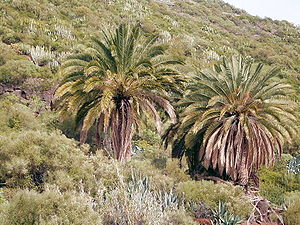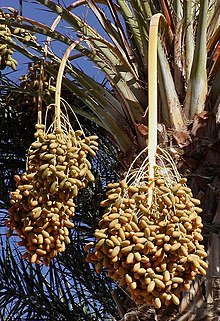Date palms
| Date palms | ||||||||||||
|---|---|---|---|---|---|---|---|---|---|---|---|---|

Phoenix canariensis on La Palma |
||||||||||||
| Systematics | ||||||||||||
|
||||||||||||
| Scientific name of the tribe | ||||||||||||
| Phoeniceae | ||||||||||||
| J. Presl | ||||||||||||
| Scientific name of the genus | ||||||||||||
| Phoenix | ||||||||||||
| L. |

The date palms ( phoenix ) are a genus of palms native to the Old World . The lower leaflets of the pinnate leaves , which have been transformed into thorns , are characteristic . The genus of date palms comprises 14 species that grow mainly in dry areas. The fruits of the real date palm ( Phoenix dactylifera ) are economically important .
description
Appearance and trunk
The representatives are dwarf to large, creeping to upright, reinforced palms. They are single or multi-stemmed. The trunk is often enveloped by the helically arranged leaf bases.
leaves
The leaves are induplicate (folded in a V-shape), pinnate and wither before falling off. The leaf sheath forms a fibrous network. The petiole is very short or well developed. On the upper side (adaxial) it is furrowed to flat or ribbed, the lower side (abaxial) is rounded. The rachis is long, gradually narrowed, adaxially round or flat. It ends with a leaf. The leaflets are simply folded, pointed, regular or grouped. The lowest are turned into thorns and are called acanthophylls . The veins run parallel, the midrib is usually clearly visible on the underside. The leaves often have scales, and sprouting leaves are often provided with a brown, flaky indument and / or wax .
Inflorescences
The date palms are dioecious . The inflorescences are between the leaves and are simply branched. Male and female inflorescences are similar to each other. The peduncle is flattened, short to long. In female inflorescences, it often elongates after the flowers have been fertilized. The cover sheet is often rod-shaped, sometimes bilobed. It is double-keeled, hairless or flaky. Other bracts are inconspicuous. The inflorescence axis is flattened and usually shorter than the stem. The lateral axes are unbranched, numerous, and are often screwed in groups along the axis. Triangular bracts are arranged helically on the side axes, each with a single flower in the axilla.
Flowers and fruits
The male flowers have three fused sepals that have fused into a flat cup. The three petals are pointed or rounded and much longer than the calyx. There are usually six stamens , less often three or nine. Their stamens are short, erect, the anthers are straight and open laterally (latrors). A rudiment of the pistil is missing or consists of three abortive carpels or is a small, trilobal remnant. The pollen grains are ellipsoidal , bisymmetrical or slightly asymmetrical. The germ opening is a distal sulcus . The longest axis is 17 to 30 micrometers long.
The female flowers are spherical. The three sepals have grown together to form a three-lobed cup. The petals overlap, are clearly annoyed and at least twice as long as the calyx. There are usually six staminodes . The three carpels are not fused together. They are egg-shaped and end in a short scar . The ovule is attached adaxially to the base of the carpel and is anatropic .
The fruit usually only develops from a carpel. It is oval to elongated, the scar remains apical. The exocarp is smooth, the mesocarp fleshy and the endocarp membranous. The seed is elongated, the endosperm is homogeneous, only rarely furrowed (in Phoenix andamanensis ). The primary leaf is undivided and narrowly lanceolate.
Chromosome number
The number of chromosomes is 2n = 32 or 36.
Distribution and locations
The genus is from the Atlantic islands off Africa over all of Africa including Madagascar , to Crete and from southern Turkey over the Near and Middle East, India to Hong Kong , Taiwan , the northern Philippines , in the southeast to the Malay Peninsula and northern Sumatra spread.
Most species grow in semi-arid areas, but always near watercourses, oases or sufficient groundwater. Some species grow in areas of the tropical monsoon . Phoenix paludosa grows on the landside edge of mangrove forests . Phoenix roebelenii is a rheophyte on the Mekong , so it grows in rivers.
Systematics
The genus Phoenix L. alone forms the tribe Phoeniceae within the subfamily Coryphoideae . Her sister group is not confirmed, various studies indicate a close relationship with the Triben Trachycarpeae , Sabaleae and Cryosophileae .
The Royal Botanic Gardens, Kew's World Checklist of Selected Plant Families recognizes the following species:
- Phoenix acaulis Roxb. : The homeland is the Himalayas to Assam .
- Phoenix andamanensis S.Barrow : The homeland are the Andamans .
- Phoenix atlantica A. Chev. : Cape Verde is the home of this unclear species.
- Phoenix caespitosa Chiov. : The homeland is the southern Arabian Peninsula, Djibouti and northern Somalia.
- Canary Island Date Palm ( Phoenix canariensis Chabaud ): The home is the Canaries.
- Real date palm ( Phoenix dactylifera L. ): The home is the Arabian Peninsula as far as southern Pakistan, but the species is cultivated worldwide in areas with a similar climate.
- Phoenix loureiroi Kunth : The range extends from India to southern China and the Philippines.
- Mangrove date palm ( Phoenix paludosa Roxb. ): The range extends from India to Sumatra.
- Ceylon date palm ( Phoenix pusilla Gaertn. ): It is native to southern India and Sri Lanka .
- Senegalese date palm ( Phoenix reclinata Jacq. ): The original range includes Africa, the Comoros, Madagascar and the southwestern Arabian Peninsula.
- Dwarf date palm ( Phoenix roebelenii O'Brien ): The range extends from northern Indochina to Yunnan .
- Cliff date palm ( Phoenix rupicola T.Anderson ): The home is the eastern Himalayas to Assam .
- Silver date palm ( Phoenix sylvestris (L.) Roxb. ): The range extends from India to Myanmar.
- Cretan Date Palm ( Phoenix theophrasti Greuter ): The range includes Crete and southwestern Turkey.
The generic name Phoenix is the Latinized spelling of the ancient Greek name for date palm or palm in general. The name is part of several other generic names of palm trees.
Web links
- Phoenix on the homepage of the Fairchild Tropical Botanic Garden
literature
- John Dransfield, Natalie W. Uhl, Conny B. Asmussen, William J. Baker, Madeline M. Harley, Carl E. Lewis: Genera Palmarum. The Evolution and Classification of Palms . 2nd Edition. Royal Botanic Gardens, Kew 2008, ISBN 978-1-84246-182-2 , pp. 242-245.
Individual evidence
- ↑ Rafaël Govaerts (ed.): Phoenix. In: World Checklist of Selected Plant Families (WCSP) - The Board of Trustees of the Royal Botanic Gardens, Kew . Retrieved November 15, 2014.
- ↑ a b Sasha C. Barrow: A Monograph of Phoenix L. (Palmae: Coryphoideae). In: Kew Bulletin. Volume 53, No. 3, 1998, pp. 513-575 ( JSTOR 4110478 ).


